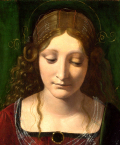The question "Who is Mona Lisa?" could have been answered centuries ago, if the language of the Middle Ages and the Renaissance, the symbolism, had not already been forgotten by the 17th century. Once more we must learn this language used by our forefathers over thousands of years of history.
The dress and the Sforza symbols shown at the upper part of the neckline of "Mona Lisa" tell us that the depicted lady is in fact Isabella of Aragon (1470-1524), daughter of King Alfonso II of Naples and wife of Duke Gian Galeazzo II Maria Sforza of Milan. However, we are nowadays so distant from the truth regarding "Mona Lisa" and the life of her great court painter Leonardo da Vinci that it is no longer enough to support this theory with contemporary written and pictorial historical sources. We need the help of anthropology.
The most famous portrait painting in the world can be found in the Louvre museum, Paris, under the name of "Mona Lisa" (Fig. 1). During the research for my book "Who is Mona Lisa? In search for her identity"1 and ongoing further investigations, it became apparent that what had been promoted as historical facts about the identity of "Mona Lisa" for over a hundred years were merely assumptions. Critical thinking about this painting has become a rarity.
Careful library research, however, has shown that the answer to the question, "Who is Mona Lisa?", could have been answered centuries ago." From the 2012 Presentation in Florence, Italy by historian and author, Maike Vogt-L├╝erssen. To read the full Presentation with the references and end notes, see: http://www.kleio.org/Florence2012/Pre...
For more information about Isabella of Aragon and her court painter, Leonardo Da Vinci, see. www.kleio.org


Comentaris publicats
Afegeix-hi un comentari: